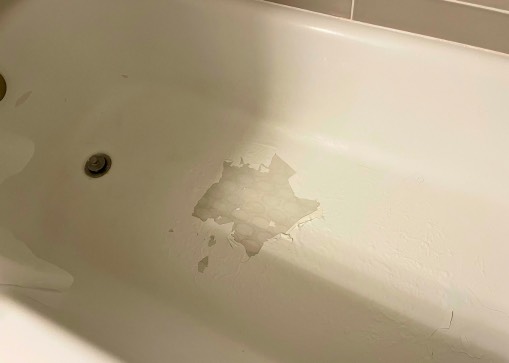
Why “Industry Standard” Coatings Consistently Fail in Bathtub Refinishing
Tub Cast vs. Polyurethane:
For decades, polyurethane coatings have been marketed as the go-to solution for bathtub refinishing. But at BathTubGuys, we’ve been in the trenches long enough to know that what’s “standard” often means “easy to sell” — not “built to last.”
That’s why we developed Tub Cast — our own exclusive coating system, purpose-built to outperform polyurethane in every meaningful way. Below, we break down the real reasons polyurethanes fail in tubs, and why Tub Cast was created to fix those problems at the root.
🧪 Why Polyurethanes Fail in Bathtub Environments (The Nitty Gritty)
Polyurethanes are flexible, fast-drying, and easy to apply — and those same traits are exactly why they don’t belong in a bathtub. Here’s what’s really going on behind the peeling and blistering:
1. Incompatible with Constant Water Submersion
Polyurethanes were never meant to live underwater. Most are formulated for automotive or architectural use — occasional water contact, not daily soaking.
What happens:
- Water vapor slowly diffuses through the coating
- It weakens the bond at the substrate level
- Over time, the coating lifts, blisters, or delaminates from the surface
Since most polyurethane refinish systems are air-dry (not baked or post-cured), they’re especially vulnerable to microchannel water intrusion — where moisture creeps in between the film and the tub, degrading adhesion from beneath.
2. Poor Adhesion to Nonporous Surfaces
Bathtubs — especially porcelain, fiberglass, and enameled steel — are non-porous and low-energy surfaces, meaning they don’t give coatings much to grip onto.
Polyurethanes rely heavily on aggressive mechanical prep (etching or sanding) plus questionable bonding agents to “stick.” But even slight application errors — like insufficient dwell time, surface moisture, or skipped abrasion — result in brittle adhesion zones.
Real-world result: The coating looks great… until it starts to peel up in sheets after a few months.
3. Extremely Sensitive to Moisture During Application
Most polyurethane tub coatings are single-component moisture-cured or two-component catalyzed urethanes — both of which are extremely moisture-sensitive during application.
If:
- The tub wasn’t fully dry
- The room has high humidity
- Moisture is trapped under tape, drain rings, or caulking…
…then the coating can bubble, reject, or cure improperly — often without any visible issue at first. Then, weeks later, it flakes, softens, or peels away.
4. Inadequate Chemical Resistance
Bathtubs are exposed to:
- Shampoos and body washes (which often contain alcohols and surfactants)
- Bleach-based cleaners
- Hard water minerals
- Soap scum and skin oils
Most polyurethane topcoats don’t have the chemical crosslink density required to withstand that cocktail of abuse long term — especially in hot water conditions. Over time, the coating becomes soft, worn, or chemically eroded, especially around high-contact areas like the drain and back wall.
5. Low Film Thickness and Coverage Integrity
Many polyurethane kits are sold based on speed and coverage, not quality. Applicators are encouraged to stretch material over 2–3 tubs to save money. The result is thin film builds that:
- Have poor moisture barrier properties
- Don’t fully level or self-heal
- Are prone to pinholes, leading to moisture intrusion and failure under the surface
6. No Public Testing Data
Ask a polyurethane coating supplier for:
- Water submersion testing
- Adhesion testing to porcelain or fiberglass
- Long-term color stability reports
You’ll probably get nothing — or a PDF with vague specs and no real-world validation. That’s not an accident. Most of these coatings haven’t been tested for real-world tub environments, because they weren’t built for them.
And most of these coatings? They’re all coming from the same few base manufacturers, just rebranded under private labels with different names and markup.
🛡 Why Tub Cast Is Different
Tub Cast isn’t polyurethane — and it never will be. It’s a BathTubGuys exclusive epoxy-based refinishing system, designed from the ground up to solve the exact failures listed above.
✅ 1. Built for Water Submersion
Bathtubs get soaked — daily. Polyurethane topcoats? Not designed for that.
Tub Cast is formulated for full water exposure — including hot water, standing water, and high-humidity environments. It resists moisture penetration at the film level and doesn’t break down from the inside out like many urethanes.
Epoxy is considered the gold standard for marine coatings — especially when it comes to long-term adhesion under water submersion, corrosion resistance, and structural protection. This is why Tub Cast is a modified epoxy architecture.
✅ 2. Superior Adhesion to Porcelain, Steel & Fiberglass
Most tubs have non-porous surfaces — a nightmare for cheap coatings. Polyurethanes depend on surface prep bandaids like acid etching and bonding agents, but still fail due to film tension and poor substrate compatibility.
Tub Cast is a deep-bonding epoxy resin that locks onto the surface at a molecular level — creating a finish that won’t lift, peel, or shear off under temperature stress.
✅ 3. Stabilized Epoxy = White That Stays White
Yes, traditional epoxies are known to yellow over time — but we’ve changed that.
Tub Cast uses proprietary color stabilizers and UV inhibitors that delay yellowing for decades. In fact, many polyurethane-coated tubs will fail structurally (peeling, cracking) long before Tub Cast ever shows color change.
You don’t have to sacrifice durability for beauty — Tub Cast gives you both.
✅ 4. Thicker, More Resilient Film Build
Polyurethane kits are often sold thin to stretch over multiple jobs. But that leads to:
- Poor self-leveling
- Easy mechanical wear
- Early coating breakdown in high-touch areas
Tub Cast is a high-solids formula, designed to go on thicker and cure harder — forming a true protective shell over the substrate. It resists abrasion, chemical attack, and thermal shock.
✅ 5. Chemically Resistant & Easy to Clean
From soaps and shampoos to hard water and occasional bleach — bathtubs take a beating.
Tub Cast’s formula resists:
- Alcohols, surfactants, and detergents
- Mineral scale and buildup
- Mold and mildew growth
- Harsh cleaning agents (when used properly)
The result? A surface that’s easy to clean and stays clean longer.
✅ 6. Engineered Exclusively for BathTubGuys Customers
We didn’t white-label someone else’s product. Tub Cast is our exclusive formula, available only through BathTubGuys. It was created to meet the quality standards we hold ourselves to — because when our name is on the job, failure is not an option.
This isn’t a product we bought — it’s a system we built.
We’ve eliminated the weak points, added the chemistry refinishing truly requires, and built a system that we’re proud to use in every customer’s home.
🧼 Final Word
Polyurethanes are fast, cheap, and easy to spray — and that’s exactly why they fail. They were never meant for tubs, never properly tested, and never made with the long-term interest of the customer in mind.
Tub Cast was born out of necessity — because we were tired of coatings that couldn’t keep up with the level of work we do at BathTubGuys.
We don’t use industry standard.
We created our own standard.
Sources
- NAPCO Ltd. – “Bathtub Reglazing Problems & How to Avoid Them”
https://www.napcoltd.com/bathtub-reglazing-problems-how-to-avoid-them/ - Refinished Bath Solutions – “The 4 Most Common Issues That Arise With Tub Resurfacing”
https://refinishedbathsolutions.com/blogs/news/the-four-most-common-issues-that-arise-with-tub-resurfacing - AAA Bathtub Refinish – “Common Bathtub Refinishing Problems”
https://aaa-bathtubrefinish.com/bathtubs-refinishing-and-their-common-problems/ - Renew Services – “Adhesion Failures Explained”
https://www.renewservices.com/common-problems-and-solutions/adhesion-failures/ - Surface Doctors – “7 Common Bathtub Refinishing Mistakes to Avoid”
https://thesurfacedoctors.com/7-common-bathtub-refinishing-mistakes-to-avoid/ - Tri-Cities Reglazing – “Common Bathtub Reglazing Problems”
https://tricitiesreglazing.com/bathtub-reglazing-problems/ - Wikipedia – “Bathtub Refinishing”
https://en.wikipedia.org/wiki/Bathtub_refinishing - Wikipedia – “Epoxy”
https://en.wikipedia.org/wiki/Epoxy - ArtResin – “Why Some Epoxies Yellow Over Time”
https://www.artresin.com/blogs/artresin/41958017-why-do-some-brands-of-epoxy-resin-turn-yellow - Journeyman HQ – “5 Best Epoxy vs. Acrylic Options for Bathtub Repairs”
https://www.journeymanhq.com/139714/5-best-epoxy-vs-acrylic-options-for-bathtub-repairs/
